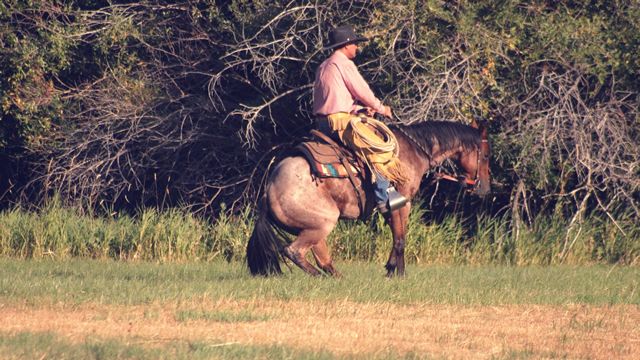Written by Martin Black
This article originally appeared in Eclectic Horseman Issue No.21
Getting a horse to stop isn’t only necessary in most riding disciplines but is also a safety precaution at some point for most all riders if things ever get out of control. If a horse doesn’t understand to stop, it can be difficult to check his speed to prevent a hazardous situation.
There are various ways to develop a stop and various ways for a horse to stop for various reasons. I am not going to get into the finer points of a big sliding stop on the hindquarters or what I call a cowhorse stop, which the horse uses all four quarters to stop. We need to develop the idea, the basic concept first, and from that we can refine a high-performance stop.
This simple exercise can help with an older horse that isn’t putting out much effort or a young inexperienced horse that just doesn’t know. One thing the rider needs to understand is how we affect the horse’s balance and natural way of moving and operating when we pull hard enough that the horse engages muscles to resist the pull. The other response is when the horse is supple enough to overflex or get too much bend that he has to transfer the weight on the front and the hindquarters to compensate for his head and neck in an unnatural position.
With a light enough pull on the reins, and keeping our weight close to the center of gravity into and through the stop, the horse can perform with the least distraction from us and find out how to balance himself to stop.
The idea of this exercise is to find a speed (probably a trot or a slow lope) that will cause the horse to work a little, but not get confused. Once he works for a while, and realizes the pressure is consistent and the relief is also consistent, he will avoid the pressure area and want to stay in the relief area you are offering. The concept to remember is: It takes relief for pressure to be effective, and pressure for relief to be effective. The balance of these two will develop a confident, compliant, and motivated horse. When he experiences too much relief, he will be lazy, resentful, or bored. When he experiences too much pressure he can become nervous, mad, frustrated, confused, or overanticipate the maneuver. Using good judgment in this area will determine your success or failure.
To set this exercise up, find an area with good footing where you can make a circle that you will complete approximately every ten seconds or so. This timing allows the horse enough time to relax between maneuvers without losing his train of thought.
As you come in a circle to the left, pick a spot to stop and roll back to the right, then you will make a right circle and come to the exact same spot, stop and roll back to the left and make another left circle and continue with this. Each circle will be on top of the last, and each stop will be in the same spot. As you ask your horse to stop, your body rhythm will stop; then just take the slack out of the reins. If you feel better saying whoa, that’s fine, but he will read your body rhythm also.
Choose a speed that with a light pull on the reins would bring your horse to a walk in around four steps. Just one or two steps before the horse slows to a walk, pull one rein just hard enough to elevate the head but not panic the horse. If the horse panics, he will respond without thinking, but if he doesn’t elevate the head he is not acknowledging the discomfort, and this is what is going to motivate him to look for a more comfortable deal. When you affect the horse properly, this should only take a few times to make a slight change, and the horse should start putting more effort into the stop. When you see the change, don’t roll back, but just stop and wait for the horse to relax. Put your hands on his neck and let your reins long to let your horse know you quit for that session and try again later.
Remember, to look for the effort to reward, and do not prepare to pull the reins. He may take a deep breath or lick his lips. He is fully realizing the relief at this point and this is going to motivate him to put effort in the stop and be relaxed and confident. After two or three slight improvements, quit for the day, and don’t get hung up on looking for a certain level of performance.
This article originally appeared in Eclectic Horseman Issue No.21


